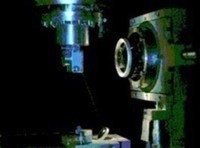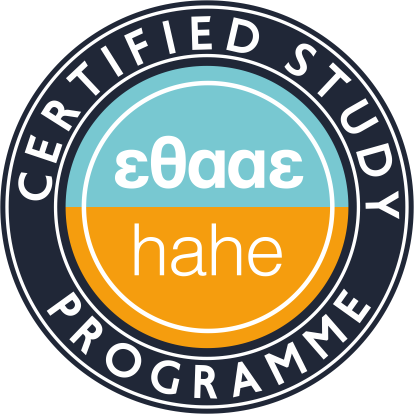Laboratory of Theoretical and Computational Solid-State Physics
The computational study and analysis of a real problem in solid-state physics, the implementation of computational methods for the research and prediction of physical phenomena or the behavior of physical systems is an extension of theoretical science based mainly on physical, mathematical and computational methods.
It can be used to explore new theories and to model and simulate new experiments. It is an alternative when the phenomena are not easy to observe or when the experimental measurements are impractical, time consuming or costly.
In recent years with the exponential increase of computing power, computational simulation has emerged as a powerful tool that has revolutionized the research field of solid-state physics and beyond. The use of simulations and computer models is pervasive in all areas of solid-state science and at every stage of a researcher's life cycle.
In addition, computational materials physics in the Department of Physics over the last decade is undoubtedly a field of excellence with a number of courses taught both at the undergraduate level and in the two major postgraduate courses "Materials Physics & Technology" and "Computational Physics". Several related high impact factor publications have been published in recent years.
The laboratory aims at the development of activity and / or the connection with fields of education, of society, of administration, of economy related to the fields of interest of the laboratory.
Laboratories of Theoretical and Computational Solid-State Physics are among the fastest growing laboratories in the last two decades worldwide.
Computer simulations take us closer to a new era. It is the key to progress in the field of science, having over the last decade a solid impact on all its sub-sectors. Computational simulations have grown rapidly as a tool in recent years as mathematical modeling, computational algorithms, computing speed, Big Data era and the computing infrastructures have also greatly developed. High Performance Computing (HPC) -based simulations have a huge impact on industry and research worldwide.
Phone number: +30 2310 998312
Email: cossphy ΑΤ auth.gr
DIRECTOR
Joseph KioseoglouMEMBERS
RESEARCH ACTIVITY

By using spectroscopic techniques (Raman, IR, absorption, Photoluminescence) and the synergy of theoretical calculations (phenomenological models, first-principles calculations, group theory) the optical properties of a wide range of materials (semiconductors, fullerenes, carbon nanotubes, garnets, low-dimensional materials etc.) are studied. These techniques and theoretical methods are utilized for materials characterization (identification of polytypes and phases, crystallinity, presence of mechanical stress/strain, chemical functionalization, electronic doping etc.) as well as for the study of fundamental physical phenomena (electron-phonon interaction, Kohn anomalies, immediate neighboring interactions etc.).
Moreover, the influence of external perturbations (temperature, uniaxial or biaxial mechanical deformation, hydrostatic pressure, electrochemical doping etc.) modifies drastically the optical properties of a material providing, thus, information on the physical phenomena themselves and allows the investigation of structural stability and the study of pressure induced structural or electronic phase transitions of materials.
- Indicative activities:
- Study of optical properties under normal conditions, high pressure and as a function of temperature of materials such as semiconductors (ΙΙΙ-V, II-VI), fullerenes and related compounds, chemically modified carbon nanotubes and scheelite compounds (ABO4, Α = Ca, Sr, Ba and B = W, Mo).
- Study of the optical properties of two-dimensional materials such as graphene (single or multilayers), BN, transition metal dichalcogenides (MoS2, WS2, Mo1-xWxS2, MoSe2) as a function of their interaction with various substrates, physical or chemical electronic doping, mechanical deformation and hydrostatic pressure.
- Study of III-V nitrides (AlN, Gan, InN and their alloys) using Raman spectroscopy: effect of ion implantation and doping as well as of the stresses induced during the epitaxial growth.
- Lattice dynamics of the rare earth aluminum and gallium garnets in a crystal form and as solid solutions (RE3Al5O12 and RE3Ga5O12, RE=rare earth).
- Equipment:
- Raman and photoluminescence set-up consisted of a triple monochromator (DILOR ΧΥ) with gratings of 1800 lines/mm and a CCD (EG&G 1433-C) liquid-nitrogen-cooled detector.
- Raman spectrometer RAMALOG 5 equipped with a Peltier-cooled photomultiplier tube with GaAs photocathode and a triple-monochromator that covers the wavelength range 12000 – 28000 cm-1 (8500-3500Å), fully automated and PC controlled.
- Two Ar+ Lasers of Spectra Physics 2W.
- One Kr Laser of Lexel 1.5 W.
- One cryostat accompanied by a diffusion pump of Cryogenic that works down to 20 K.
- Gas membrane driven diamond anvil cells, micro-tensiometers for the application of mechanical deformation (uniaxial, biaxial).
RESEARCHERS

Quantum dots and nanowires are widely studied due to their potential electrical and/or optical properties.
Their successfull and reproducible fabrication still remains a challenge for the scientists
The scientific activity of our group involves: Atomistic modelling, determination of atom equilibrium positions with simulation methods, electronic state and optical property evaluation.
RESEARCHERS

•Research Activities:
- Cognitive studies in Physics.
- Development of teaching activities (traditional and advanced technology).
- Development of integrated learning environments.
• Equipment:
1. Closed-loop TV circuit with capability of mixing sound and video in digital format (DVD), 4 SONY cameras, ZOOM 6x, video mixing console, U'matic video 3/4 250 lines.
2. Portable color video recorder JV-VHS 250 lines and video camera JVC KY-610, f = 1.4, ZOOM 10x.
3. Stereo color TV set (46").
4. Portable sound mixers (4 & 6 channels), directional and ambient microphones.
5. Devices for demonstration experiments in the fields of Mechanics, Electricity, Magnetism and Fluids.
6. Projectors for still and moving images.
7. A collection of videotapes VHS and DVD with experiments in Physics and a collection videotaped past student presentations.
8. Setups for on line measurements (MBL) and projection of educational activities.
RESEARCHERS

The Electron Microscopy Laboratory (EML) of Physics Department was established in 1963. The Lab is located at the west wing of the Science School and belongs to the Solid State Physics Section of the Physics Department. Today, the Lab comprises seven research staff members and two staff for technical support. The Lab hosts PhD and MSc Students, as well as Marie Curie Research fellows. The mission of EML is to provide to its members access to materials characterization equipment, training, and consultation, as well as to perform a range of services for end-users in the area of electron microscopy. In general, the laboratory’s activity comprises the integrated structural characterization and study of solid materials (metals, ceramics, polymers, glasses), as well as complex materials and composite crystals of advanced materials such as semiconductor thin films, nanostructures and heterostructures, natural or engineering materials in powder form and coatings. Μore specifically, the current research activity includes:
•Study and structural characterization of various materials (metals, semiconductors, ceramics, polymers, composites and advanced materials) by various transmission electron microscopy (TEM) techniques.
• Study of the nanostructure and structural defects of bulk materials, thin films and nanomaterials by High Resolution Transmission Electron Microscopy (HRTEM).
• Localized crystallographic and topological characterization of phases, interfaces, symmetries, orientation relationships, polarity, and line, planar or other extended structural defects.
• High accuracy nanoscale determination of internal strain fields.
• Structural and chemical characterization of homophase and heterophase interfaces down to the atomic scale.
• Integrated structural characterization of nano-heterostructures such as quantum wells, quantum dots, and nanowires.
• Study of nano-scale interaction mechanisms between defects, interfaces, internal fields and the kinetics of growth.
• Growth and characterization of engineering materials fabricated by advanced methods mechanosynthesis and thermal treatment.
• Study of phase transitions and vitrification of amorphous glassy materials.
• Research of transformation of phases and the crystallization of amorphous alloys by in situ thermal treatment.
• Development of integrated models of structures, interfaces and defects through the simulation of CTEM and HRTEM observations by computational methods such as Molecular Dynamics, ab initio DFT, and Monte-Carlo.
• Development of methods and software form quantitative HRTEM (qHRTEM) analysis (e.g. peak finding methods).
• Electron microscopy simulations of diffraction patterns, CTEM and HRTEM images. Software development for the processing and analysis of TEM images and diffraction patterns.
• Study of surface morphologies and properties by atomic force microscopy (AFM).
Through collaborations with international acknowledged electron microscopy centres:
- Two-dimensional nano-scale chemical mapping
- Chemical imaging of atomic structures.
- Nano-scale quantitative determination of chemical concentration.
- Nano-scale chemical profile determination across interfaces.
- Analysis of chemical bonding.
Instrumentation
The EM Laboratory possesses the necessary instrumentation for the precise HRTEM and CTEM characterisation of solid matter, as well as state-of-the-art instruments for TEM sample preparation, such as:
• High Resolution Transmission Electron Microscope JEOL 2011 (200KV), with a point resolution of 0.194 nm (purchased 2001). The microscope is equipped with:
i. KeenView G2 TEM CCD camera system (Olympus Soft Imaging Solutions)
ii. SPININGSTAR P020 device, for the precession and tilting of the electron beam (Nanomegas) accompanied with the necessary software.
• High Resolution Transmission Electron Microscope JEOL 2000FX (200KV), with a point resolution of 0.28 nm (purchased 1992).
• Conventional Transmission Electron Microscope JEOL 1010 (100KV) with a resolution 0.5nm, with heating, cooling and tensile stress facilities (purchased 1978).
• Atomic Force Microscope (AFM) Explorer 2000 Truemetrix Topometrix, with two scanners of (100X100) μm, (2.5X2.5) μm, and a liquid scanner of (2.5X2.5) μm. Resolution in the nanometre scale. Working at Contact mode, Tapping mode, Lateral Force mode.
• Argon ion-milling machines: Edwards (model IBMA2), MTA-MFKI and TECHNOORG LINDA with a liquid nitrogen facility.
• Precision ion polishing system, PIPS Gatan (model 691).
• Diamond lapping and polishing machine for use with the tripod polisher, South Bay Technology (model 910).
• Precise semi-automated grinding/polishing equipment, Allied MultiPrep.
• Precision dimpling instrument, South Bay Technology (model 515).
• Electropolishing devices Tenupol-2, Tenupol-3 (Struers).
• Dark room facility.
• Software for HRTEM image processing and simulations.
RESEARCHERS

Activities:
- Dynamics and Kinetics of disordered solid state systems and fractals.
- Dynamics of neural networks and signal transfer.
- Estimation of electronic and optical properties of conventional and novel semiconductor material with technological applicability.
- Interface study (symmetry, energy and structure features) in polycrystalline materials with lattice model.
- Study of crystallite triplets in polycrystalline materials.
- Estimation of electronic and dynamic properties in crystals, amorphous materials, superlattices.
- Properties and Critical phenomena in ionic crystals.
- Lattice dynamics of crystalline solids (3D and 2D) using phenomenological models and first-principles calculations. Application of group theory for the interpretation of Raman and Infrared spectra.
- Difussion modelling, random walk, complex systems, low-dimensional systems, fractals, trapping events. - Statistical Physics Methodology.
Equipment:
PC Lab with parallel processing. Consists of 32 PCs (Intel Core 2 Duo, 64 processors), Total RAM 128 Gb, Storage Space 6.7 Tb, Operating System Scientific Linux.
